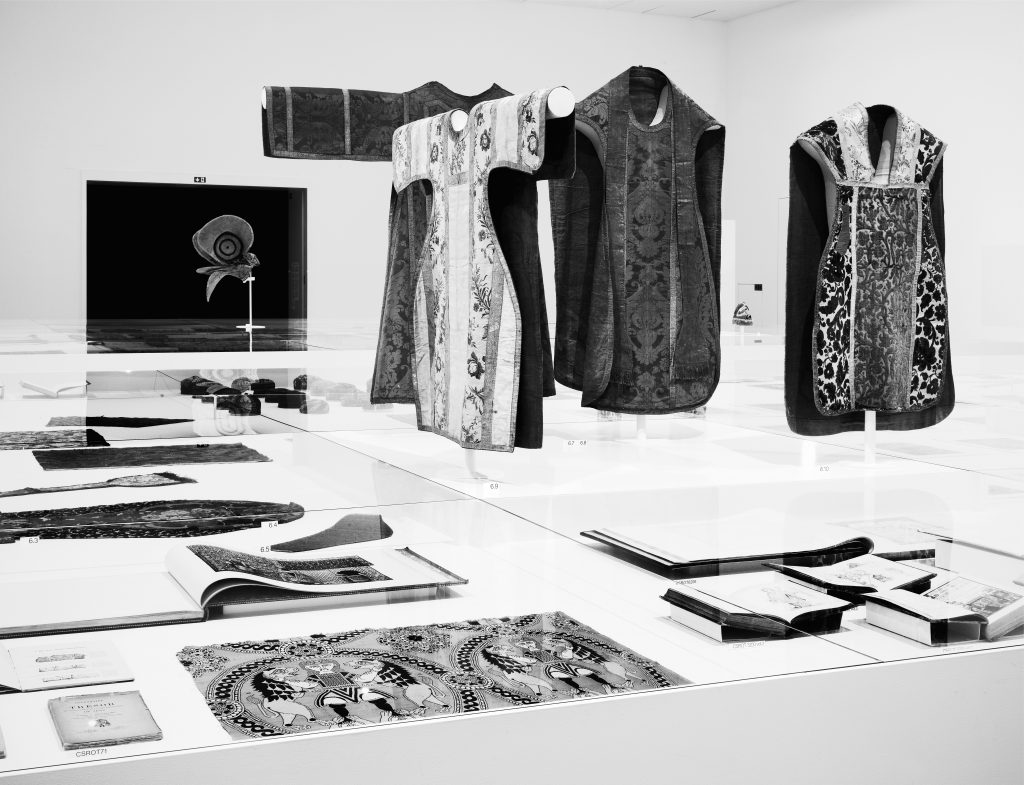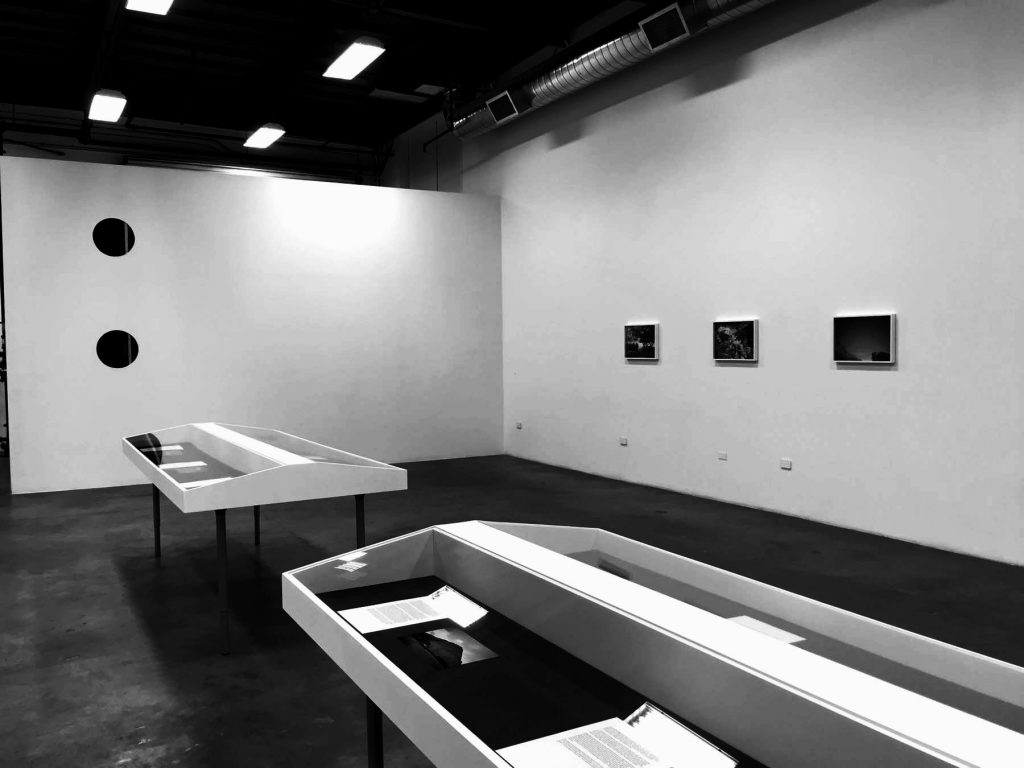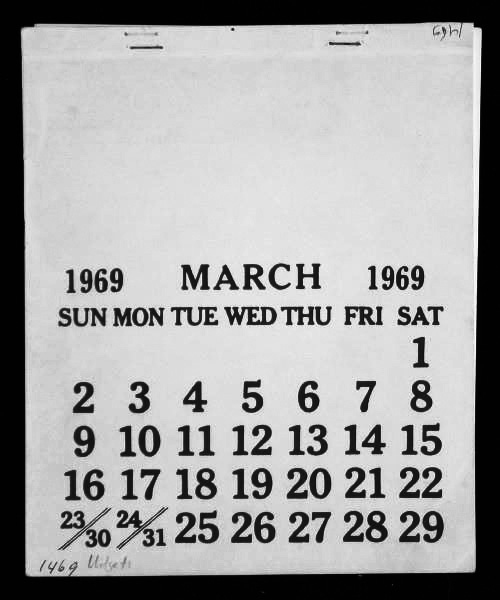A Tapestry of Thoughts
Seth Siegelaub: Beyond Conceptual Art
Stedelijk Museum, Amsterdam
12.12.15 – 17.04.16
I am unpacking my library. Yes, I am. The books are not yet on the shelves, not yet touched by the mild boredom of order. … Instead, I must ask you to join me in the disorder of the crates that have been wrenched open … to join me among piles of volumes that are seeing daylight again after two years of darkness, so that you may be ready to share with me a bit of the mood – it is certainly not an elegiac mood, but rather one of anticipation – which these books arouse in a genuine collector.
The invitation is Walter Benjamin’s, asking the reader to share his excitement in rediscovering his books after being separated from them for years. His 1931 essay, Unpacking my Library, is not so much about the accumulated knowledge contained in Benjamin’s library as the heightened state of mind of the book collector. Benjamin, a genuine collector, observed that the passion of every collector borders on the chaotic, and that the library, in essence a chaos of books, finds its counterpoint in the order of its catalogue. As he concluded, ‘There is in the life of the collector a dialectical tension between the poles of order and disorder.’
I had to think of Benjamin’s observations when I found myself sitting amid a disarray of books and dozens of half-unpacked cardboard boxes. They belonged to Seth Siegelaub, an avid book collector, and their contents needed to be catalogued after his sudden death in 2013. Administrative drudgery, you would think, but no: every box revealed a fascinating ‘chaos’ of books. It could hold a year’s issues of 1930s magazines on embroidery, antique manuscripts with dye recipes, or titles on textile crafts from around the world, including Guatemalan Textiles Today: The Art and Technique of Weaving, Dyeing, Spinning, Crocheting, Looping, and Netting in Guatemala Today ( 1978 ), or The Art of Bobbin Lace: A Practical Text Book of Workmanship ( 1908 ). The same box might also contain publications on the social history of specific crafts or the economic development of the textile industry and trade, such as La Technique et l’Organisation de la Draperie à Bruges, à Gand, et à Malines au milieu du XVIe. Siècle ( 1920 ).
As random and disjointed as this all first seemed – covering different periods, geographies, academic disciplines and socio-political fields – as I worked my way through them, a narrative pattern started emerging, and with each box I opened, the intricate web of knowledge and materials that Seth Siegelaub had assembled increasingly peaked my interest.
The books are part of the Center for Social Research of Old Textiles ( CSROT ), a one-man research institute dedicated to investigating the socio-economic history of handmade textiles, which Siegelaub founded in the late 1980s. As well as building CSROT’s comprehensive archive and expanding his collection of antique textiles from around the world, he also tirelessly constructed a detailed bibliography, each item meticulously described and systematically indexed. In 1997 he published the Bibliographica Textilia Historiae: Towards a General Bibliography on the History of Textiles, the first general bibliography on the subject ever published.
Parts of the CSROT library and the Seth Siegelaub Textiles ( SST ) collection are currently on view in the exhibition Seth Siegelaub: Beyond Conceptual Art at the Stedelijk Museum in Amsterdam. Arranged alongside cross-sections of rare antique books and more recent volumes are the most exquisite and delicate textiles from Europe and far afield, collected by Siegelaub on his travels. Most of the fabrics show traces of wear, in keeping with the nature of his interest in them, which concerned not merely their aesthetic beauty, but the histories they lived and convey. ‘Textiles’, he wrote, ‘occupy an interesting place in our history: they are intertwined with the history of the applied arts on the one hand, and with commerce and economic developments on the other.’
Seth Siegelaub: Beyond Conceptual Art is a survey of Siegelaub’s life’s work, highlighting not just his pioneering projects of the 1960s, making him the ‘Father of Conceptual Art’, but dedicating equal space to lesser-known activities that he developed while living in Paris and Amsterdam. Occupying the notoriously difficult 1,100 m2 exhibition space in the museum’s new wing, the exhibition is broadly in three sections. To the right is a richly documented survey of each of the legendary art projects that Siegelaub developed with Lawrence Wiener, Robert Barry, Joseph Kosuth and the Dutch artist Jan Dibbets, among others, in New York in the 1960s. The centre of the exhibition offers a cross-section of left-wing publications that Siegelaub collected or published in Paris in the 1970s and 80s, and on the left is a selection of exquisite textiles from the SST collection, accompanied by books and documents from the CSROT library.
Curating a comprehensive overview of Seth Siegelaub’s achievements is no straightforward task. How does one pay due tribute to a man who was a gallerist and dealer in antique carpets; who stood at the cradle of New York’s conceptual art movement, organising such experimental exhibitions as The Xerox Book ( 1968 ) and January 5–31, 1969, which introduced the ‘catalogue-as-exhibition’; a man who published artists’ books, political pamphlets and translations of such controversial works as Mattelart and Dorfman’s How to Read Donald Duck: Imperialist Ideology in the Disney Comic ( 1979 ); who was engaged in political activism, ran a one-man press and news network ( the leftist PP+NN, 1972 ), drafted the first artist contract ( The Artist’s Reserved Rights Transfer and Sale Agreement, 1971 ), was an archivist and bibliographer, a self-taught researcher running interdisciplinary research institutes and, of course, an obsessively curious collector, who spent his money on books and textiles?
‘Seth was a modern homo universalis,’ writes Marja Bloem, his ex-partner and co-curator of the exhibition, ‘someone who didn’t let himself be bracketed into one category, nor wished to spend his entire life specialising in one thing.’ When asked why he abruptly had left his successful career in the art world and moved to Paris in 1972, Siegelaub answered, ‘I don’t like to repeat myself too much – which of course is the essence of success. I try to avoid comfortable, often uncritical situations by transforming my interests every ten or fifteen years.’
The threefold structure of the exhibition appears to follow this rhythm: New York and Conceptual Art; Paris and Political Publishing; Amsterdam and the History of Textiles. But instead of using partitioning walls, dividing the exhibition in clearly defined sections, the curators chose an open structure, allowing long lines of view across the space, which generated fascinating and unexpected connections. The Oriental carpets, which Siegelaub exhibited in his New York gallery alongside paintings by Jackson Pollock and Willem de Kooning, for example, can be linked with a geometrically patterned fabric from a Peruvian Chimu carpet ( AD 1000–1200 ). His love of lists seems to be a recurring motive throughout his life: lists with artist names, titles etc. used systematically to plan his projects, down to the detailed indexes in his bibliography on old textiles. But one the most significant threads that appears out of this rich and hybrid overview, connecting the wide array of activities, is Siegelaub’s passion for the book, as a bearer of knowledge, as a democratic medium to circulate knowledge, as a designed object, and as an alternative exhibition space. His catalogue-as-exhibition projects may now be deemed ( or even canonised ) a dematerialisation of the artwork, but Siegelaub cared about books as objects, their material and aesthetic qualities, printing, font, how they were made, etc.
Siegelaub’s outspoken left-wing political engagement is another theme that runs through the various projects on display. Like the artists with whom he worked, he distrusted established conventions and economic power structures in the art world. By producing art in limited editions and creating exhibitions as books, rather than in ‘hallowed’ gallery or museum spaces, Siegelaub rejected the aura of the ‘authentic’ art object, and the prices that accompanied it. The catalogue-as-exhibition was an aesthetic experiment, but also an institutional critique.
The pompous names and acronyms, and the fact that they comprised only a single person, were a tongue-in-cheek commentary on the conventional academic system. However, although these were the product of one man’s convictions, Siegelaub was no soloist. Both as a curator and as a researcher he was deeply embedded in social networks. In contrast to conventional academic practice, his research method consisted of long kitchen-table discussions with artists in New York, and activists and political thinkers in Paris. It provided him with a rich variety of sources and materials, which were often overlooked – or ignored – by the official institutions.
The dialectical tension, as Walter Benjamin calls it, between the organic chaos of this intuitive collecting and the meticulous ordering in lists, indexes and bibliographies is perhaps the key to unlock the intricacies of Siegelaub’s practice. In the far left corner of the room the curators installed a small watchtower, offering a bird’s-eye view of the exhibition: five decades of collecting, producing, publishing and distributing, mapped out like an atlas, through which new trajectories can be drawn.
Seth Siegelaub: Beyond Conceptual Art gives us an excellent perspective of how knowledge and materiality were interwoven in Seth Siegelaub’s varied practices. It is also an indirect critique of our need to classify what cannot be classified, of the mechanisms of simplified categorisation and neatly boxing things in. The assembled objects and documentation show Seth Siegelaub’s prolific production. But it is thanks to the open structure of the exhibition, which invites us to roam and meander, and to get lost in the different periods of Siegelaub’s life, his projects, themes and interests, that we can begin to grasp the fascinating fabric of his inquisitive thinking. The fluid arrangement suits the free spirit that was Seth Siegelaub, whose meandering mind can best be understood not in terms of strict frameworks or categories, but patchworks, interwoven threads and knotted networks.
This is a revised version of ‘Seth Siegelaub – Tegendraadse Doener en Denker’, originally published in Dutch in De Groene Amsterdammer, 17 February 2016.
思想的挂毯
《赛思西格尔劳布:超越概念艺术》
阿姆斯特丹市立博物馆,阿姆斯特丹
2015年12月12日 – 2016年4月17日
我正在开箱,解封我的图书馆。 对,这些书还没有放上书架,还没有沾上秩序所带来的微弱无聊感。 ( )相反,我邀请你加入我,( 体会 )刚刚撕开的混乱箱子( )经历了两年黑暗后再次看到日光的成堆书卷,你也许会与我分享一些这些书与一个真正的收藏家形成的共鸣金一种期许,而不是一个哀伤的心情。
瓦尔特本雅明邀请读者分享他重新找到分离多年的书卷的兴奋。 他1931年的文章,《解封我的图书馆》里描述的并不主要是本雅明图书馆里累积的知识,而是他作为书卷收藏家亢奋的心态。 本雅明是一个真正的收藏家,在他的观察中每个收藏家都有可以称得上混乱的激情;而图书馆,本质上是一堆混乱的书,这与他们井井有条的书目对立。 他总结道:“收藏家的生活中有秩序和混乱这两极之间的辩证张力。”
当我突然发现自己坐在一堆混乱的书和几十个半打开的纸板箱正中时,我不由得想到本雅明的观察。这些书属于赛思西格尔劳布,他是一个狂热的书本收藏家。2013年他突然过世后,这些内容需要被编目。你也许会认为这是一份管理苦差,但其实不然:每个盒子都包含了“混乱”又迷人的书。一个盒子里可以有20世纪30年代里某一整年的刺绣杂志,古董染色方法手稿,或来自世界各地的纺织工艺品书籍,包括《今天的危地马拉纺织品:危地马拉当下纺织,染色,纺纱,编织,循环和织网的艺术和技术》( 1978年 ),或《线轴花边的艺术:一本实用的工作教科书》( 1908年 )。这个箱子里可能还有关于特定工艺的社会历史或纺织工业和贸易的经济发展的出版物,例如《16世纪中叶布鲁日、根特和梅赫伦的技术和组织》( 1920 )。
这一切第一眼看上去似乎非常随机也并不相关金 它们涵盖不同时期,地理,学科和社会政治领域 金 越来越多的书映入我的眼帘后,一个叙事模式开始出现,每个打开的盒子里都有一张复杂的知识网,( 在这过程中 )赛思西格尔劳布收集材料越来越让我感兴趣。
这些书籍是旧纺织品社会研究中心( CSROT )的一部分,这是一个致力于研究手工纺织品社会经济史的一个一人研究所,由西格尔劳布在80年代末成立。除了建立CSROT的综合档案,并扩大他来自世界各地的古董纺织品的收藏,他还不懈地构建了一个详细的书目,每个项目都有精心描述以及系统索引。 1997年,他出版了《纺织历史百科全书:面向历史的参考书目》,这是有关这一主题出版的第一本总体参考性书目。

Installation view of the exhibition Seth Siegelaub: Beyond Conceptual Art, Stedelijk Museum, Amsterdam. Photo: Gert Jan van Rooij, Courtesy of Stedelijk Museum Amsterdam. “赛思·西格尔劳布:超越概念艺术”展览现场,阿姆斯特丹市立博物馆,摄影:Gert Jan van Rooij,图片提供:阿姆斯特丹市立博物馆.
部分CSROT图书馆和赛思西格尔劳布纺织品( SST 系列收藏目前正在阿姆斯特丹市立博物馆的“赛思西格尔劳布超越概念艺术”展览中展出。 交错排列的罕见古董书被西格尔劳布从他在欧洲和其他地方旅行收集来的精美和微妙的纺织品环绕。西格尔劳布不仅关注织物的美学美感,而且关注它们生活和传达的历史,因此,大多数展出的纺织物显示出磨损的痕迹。 “纺织品”,他写道,“在我们的历史中占据着一个有趣的地位:它一方面与应用艺术的历史交织,而另一方面则与商业和经济发展不可分割”。
“赛思西格尔劳布 – 超越概念艺术”是对他一生工作的回顾,亮点不仅仅包括让他在20世纪60年代成为“概念艺术之父”的先锋项目,该展览对于他住在巴黎和阿姆斯特丹期间并不那么知名的活动也给予了同等的关注。 展览占据了博物馆新翼上出了名困难的1100平方米的展览空间,大致分为三个部分: 右侧区域是对西格尔劳布与劳伦斯维纳,罗伯特巴里,约瑟夫科苏斯和荷兰艺术家扬迪比斯以及其他人在1960年代的纽约创作的每个传奇艺术项目的详细回顾。 展览的中间区域展示了西格尔劳布在20世纪70年代和80年代在巴黎收集或出版的左翼出版物的一个横截面,而左侧是SST收藏系列里精选的纺织品,以及来自CSROT图书馆的书籍和文件。
策划一个赛思西格尔劳布的全面回顾展并不是一件容易的事。他经营古董地毯画廊; 他参与纽约概念艺术运动的发起,组织了一些实验性展览,如“复印的书”( 1968 )和“1月5日 – 31日”( 1969 ),在这些展览里“目录作为展览形式”的概念诞生;他是一个艺术家,是政治小册子和有争议的作品的翻译本的出版人,如马泰尔拉和多尔夫曼的《如何阅读唐老鸭:迪斯尼漫画里帝国主义意识形态》( 1979 )。他是一个政治活动家,经营一人新闻社和新闻网络( 左派PP + NN,1972 ),起草了第一个艺术家合同《艺术家保留转让权利和销售协议》( 1971年 )。他同时又是一个档案收编者与目录学家,一个经营跨学科研究机构自学成才的研究员,当然,还是一个将大量金钱花在购买书和纺织品上的充满强烈好奇心的收藏家?
“赛思是一个现代的博学家( homo universalis ),”他的前合作伙伴和展览的联合策展人玛利亚布卢姆写道,“他不想将他的全部生命投身于一件事,他无法被一个类别概括 ”。当被问及为什么突然离开了在艺术世界的成功事业并于1972年搬到巴黎时,西格尔劳布回答说:“我并不喜欢重复自己 ,虽然重复是成功的本质。我试图通过每十年或十五年改变我的兴趣来避免自己进入舒适,也通常是并不批判性的环境里。”

Installation of Julien Bismuth, Steganograms, The Box, Los Angeles. 朱利恩·比斯姆士《密码》,装置,洛杉矶盒子画廊.
展览的三重结构似乎遵循着这种节奏:纽约和概念艺术; 巴黎和政治出版; 阿姆斯特丹和纺织品历史。但是策展人选择了一个开放式结构,而不是使用分隔墙将展览划分成清晰定义的几部分。跨越整个空间的宽阔景象在展品间创造了令人着迷并意想不到的连接。例如,西格尔劳布在他的纽约画廊和杰克逊波洛克及威廉德库宁的画一起展出的东方地毯可以与秘鲁Chimu地毯( 公元1000-1200年 )上几何图案织物相联系。他不断产生的创作冲动似乎来源于他对“列表”的痴迷。这种“列表”可以是艺术家或作品名称的名录。他用“列表”的方式为古旧织物编制详尽的目录。但是,从对他丰富和混合的概述中出现的最重要的连接广泛活动的线索是西格尔劳布对书的热情金作为知识的承载者,作为一个民主的媒介传播知识,作为一个设计的对象,作为一个替代性展览空间。他的目录展览项目现在可以被视为( 甚至神化为 )去物质化的艺术品,但同时西格尔劳布又把书作为物件,( 研究 )它们的材料和美学价值,印刷,字体,如何制作等。
西格尔劳布公开的左翼政治参与是展览里各个项目里展示出的另一个主题。 就像与他合作的艺术家们一样,他不信任艺术世界中既定的常规和经济权力结构。通过创作限版数的艺术作品,并以书籍的形式而不是在“神圣”的画廊或博物馆空间中做展览,西格尔劳布拒绝了“正宗”艺术品的光环以及伴随其而来的高价。 目录作为展品是一种美学实验,也是一种机构批判。
虚张声势的名字和首字母缩略词以及它们只能够涵盖一个人的事实,是对传统学术体系的一个过于简单的评论。 然而,虽然这些是一个人的信念的产物,西格尔劳布并不是一个独行侠。 无论是作为策展人还是作为研究员,他的项目都植根于社交网络。 与传统的学术实践相反,他的研究方法包括与纽约艺术家和巴黎的活动家及政治思想家的厨房长桌讨论。 这样的行为给他提供了大量尤其是经常被官方机构忽略的材料。
正如瓦尔特本雅明所说,这种直观性的收集形成的有机的混乱和列表性的细致排序之间有着辩证的张力,而目录和书目很可能是解读西格尔劳布复杂的实践的关键。 在房间的最左边角落,策展人安装了一个小的暸望台,通过它可以鸟瞰展览。 五十年的收集、制作、出版和发行汇集在这里成一套地图集,新的轨迹也隐隐可见。
“赛思西格尔劳布:超越概念艺术”为我们了解他各种实践中交错复杂的知识和物质提供了一个极佳的视角。 它也是一个对无法分类的东西进行分类的欲望,和分类同时发生的简化和整齐装箱的机制的批判。这些物件和文档展示了赛思西格尔劳布多产的一生。展览以开放结构邀请观众漫游闲逛,迷失在西格尔劳布不同时期的生活、项目、主题和兴趣中,体味他那令人捉摸不透的想法。 这种充满流动性的布局符合他自由的精神,他漫游天际的思维无法以严格的框架和分类体现,通过拼贴、交织的线条和打结的网络,他的一生得到了更好的呈现。

Seth Siegelaub ( ed. ), March 1969 ( One Month ). Siegelaub invited artists to make a work on an assigned day during the month of March 1969. With Carl Andre, Robert Barry, James Lee Byars, John Chamberlain, Barry Flanagan, Dan Flavin, Robert Huot, On Kawara, Joseph Kosuth, Sol LeWitt, Richard Long, Bruce Nauman, Claes Oldenburg, Ed Ruscha, Robert Smithson, Lawrence Weiner and others. 赛思·西格尔劳布,《1969年3月( 一个月 )》。西格尔劳布邀请艺术家在1969年该月指定的一天创作一件作品。参加者有卡尔·安德烈,罗伯特·巴里,劳伦斯·韦尔,詹姆士·李·拜厄斯,约翰·尚博朗,巴里·弗拉纳根,丹·弗莱文,罗伯特·于奥,河原温,约瑟夫·科苏斯,索尔·莱维特,理查德·郎,布鲁斯·瑙曼,克拉斯·欧登伯格,埃德·拉斯查,罗伯特·史密生,劳伦斯·维纳等。